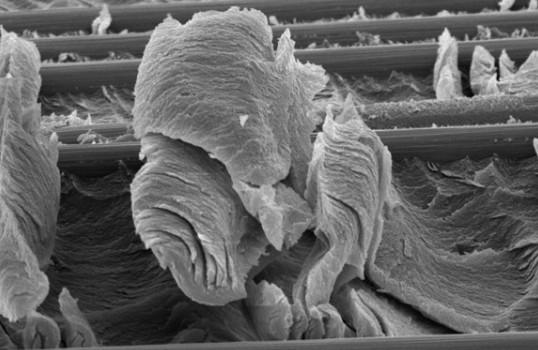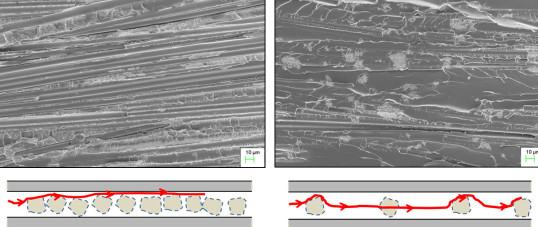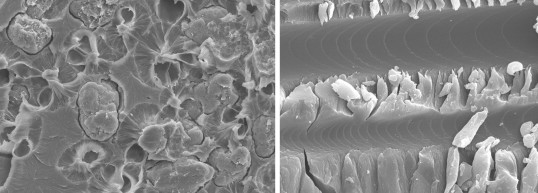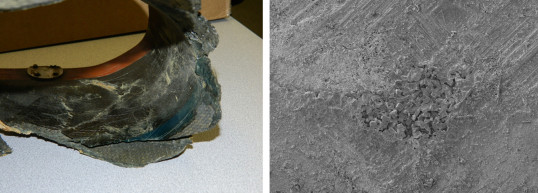Structural Power

We have conceived and demonstrated a structural material which has the capacity to store and deliver electrical energy. Structural power composites are a completely new way to use engineering materials and offers compelling opportunities for engineers to innovate and create. We anticipate structural power will be ubiquitous: our phones, cars, computers, aircraft, medical devices, infrastructure, etc. will all be realised by structural power, positioning this engineering advance at the heart of society. By offering ‘massless energy’, it could one day consign conventional (monofunctional) batteries to history. More details are given here.
Fractography of Polymer Composites

 Fractography is the study of the fracture surface morphology of failed materials and components, from which the cause, source and sequence of failure can be deduced. This is an essential tool for advancing the understanding and confidence in using composites, giving an insight into damage mechanisms and providing a link between predictive models and experimental observations. Professor Greenhalgh is the world expert in this field. As well as underpinning his research at Imperial College, his fractographic work includes acting as an expert witness in litigation cases and undertaking accident investigations on both vehicles and components (aerospace and non-aerospace).
Fractography is the study of the fracture surface morphology of failed materials and components, from which the cause, source and sequence of failure can be deduced. This is an essential tool for advancing the understanding and confidence in using composites, giving an insight into damage mechanisms and providing a link between predictive models and experimental observations. Professor Greenhalgh is the world expert in this field. As well as underpinning his research at Imperial College, his fractographic work includes acting as an expert witness in litigation cases and undertaking accident investigations on both vehicles and components (aerospace and non-aerospace). 
Underpinning material development: We have employed fractography to optimise using carbon nanotubes (CNTs) in carbon fibre polymer composites to significantly improve fracture toughness. Through scrutinising the delamination surfaces, we have deduced that introducing a homogenous distribution of CNTs (left image) promotes fibre/matrix failure whilst a heterogenous distribution (right image) forces the crack through the highly tough CNT regions, enhancing the composite toughness. Further details are given here.

Deducing failure mechanisms in composites: We have used fractography to understand how moisture and temperature influence the delamination mechanisms and performance in highly toughened composites. We are currently scrutinising fracture surfaces from delamination fatigue to understand the failure mechanisms in composites.

Failure investigation: Fractography is a vital tool for post-mortem failure analysis of in-service failures of components.
Collaborators
Dr Milo Shaffer, Imperial College, Hierarchical Composites
Dr Alexander Bismarck, Imperial College, Hierarchical Composites
Dr Joachim Steinke, Multifunctional Materials
Dr Lorenzo Iannucci, Runway Debris
Dr Robin Olsson, Runway Debris
Dr Brian G. Falzon, Imperial College, Stiffener Debonding in Stiffened Structures
Dr Paul Robinson, Imperial College, Delamination Mechanisms
Research Staff
Research Student Supervision
Apruzzese,P, Failure Modelling of Post-Buckled Stiffened Panels
Bloodworth,V, Stiffener Debonding in Post-Buckled Structures
Ibrahim,S, Active Composite Materials for Energy Absorption
Lamorinere,S, Nanotube Wettability & Modification; The key to Hierarchical Fibre-Reinforced Nanocomposites
Nguyen,S, Modelling of Stone Lofting from Runway Debris
Qian,H, Hierarchical thermoset composites with carbon nanotube grafted fibres
Rogers,C, Delamination Failure Criteria
Tran,M, Ultra-inert Hierarchical Fiber-reinforced Nanocomposites

